[ad_1]
Editor’s note: This is the second of two stories focused on the adoption of automation by small to mid-sized distributors. In the November issue, we learned how Top Notch Distributors made the leap from paper-based, pick-to-cart operations to system-directed pick-to-robots. In this issue, we revisit NorthShore Care Supply, which we featured in the September 2020 System Report, to see how and why this distributor of incontinence products is using a palletizing robot to speed up its receiving operations.
In July of 2020, early into the pandemic, I had a chance to tour a recently opened 173,000-square-foot distribution center north of Chicago operated by NorthShore Care Supply. The company was founded by Adam Greenberg in 2002, a University of Chicago MBA grad who was looking for a startup idea. He got the idea for what is now one of the leading suppliers of products for incontinence after some family members who were going through illnesses expressed their reluctance to purchase products like Depends at the grocery or drug store.
The idea of purchasing online for reasons of privacy and the convenience of home delivery seemed natural. Once he turned on the website, he learned of his customers’ frustrations with the performance of many of the products available in the stores and turned his focus to higher quality products, a customer service staff able to answer embarrassing questions, and fast and easy delivery. A business was born.
Take a closer look inside the NorthShore Care Supply operation here.
After operating for more than a decade from several smaller facilities, including an 86,000-square-foot DC about 10 miles from the new facility in Green Oaks, Ill., the new distribution center doubled the square footage and provided room to grow for a company that was then experiencing 30% year-over-year annual growth.
But the new facility—the company’s fifth since its founding—featured more than additional space. It contained a high level of automation for a small to mid-sized company. The centerpiece was a robot-to-goods picking system designed by Numina Group that used autonomous mobile robots (AMRs) from Waypoint Robotics, recently purchased by Locus Robotics. A unique feature was the robots’ capacity to carry much heavier loads than a typical AMRs, up to 700 pounds. This was essential since NorthShore Care ships full cases of product to its customers. Those cases were delivered to a fairly automated packing, labeling and shipping line.
At the time, Greenberg, the company president, told me he embraced automation for several reasons: First, it was now affordable and in the reach of mid-market companies like NorthShore Care Supply. Second, automation allowed him to build capacity into the system—he saw a 40% to 50% improvement in the speed of picking along with improvement in accuracy. And finally, automation allowed him to do more with less.
“This is not an area with a large blue-collar labor force,” Greenberg says, adding that with Amazon, Uline and Medline operating large DCs nearby, they were competing for available warehouse labor. “We were struggling to find people looking for a permanent job, and temps wanted to jump from warehouse to warehouse,” he says. “That was a challenge for the five years before Covid.”
Fast forward to July 2021, when I toured the Green Oaks facility once again. The AMRs were still traveling through the aisles, associates were busy picking to the robots and moving product through the packing stations, and lift truck operators were moving pallets to replenish pick locations.
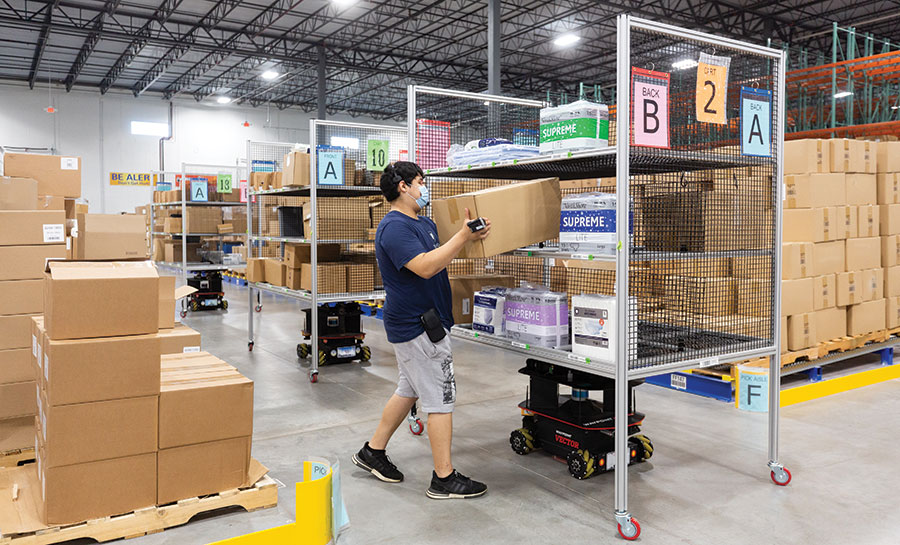
Autonomous mobile robots (top) are used for order fulfillment processes.
I saw two big differences: Significantly more inventory was in the warehouse than in July 2020, and, at the receiving dock, two associates were unloading cartons onto a powered conveyor from inside a shipping container. Those cartons were then directed to a robotic palletizing cell designed by a system integrator (Exact Automation). There, empty pallets were automatically dispensed from a pallet dispenser; cartons queued in one of two staging lanes; and a Fanuc robot picked them up two at a time to build one of 20 distinct palletizing patterns.
Like the AMRs in picking, robotic palletizing was bringing a whole new level of efficiency to the receiving operation at a time when it is desperately needed. More on that in a moment. “It was taking us 8 manhours per container to unload and most of that was on overtime,” Greenberg says. “We’ve only had the palletizing cell operational for a few months and we’re at 3 manhours for about 80% of the containers we unload. With further optimization, we think we can get that down to 2.5 hours per container.”
An added benefit: The reduction in labor associated with receiving also reduces the potential for repetitive stress injuries from repeated lifting, creating a safer work environment.
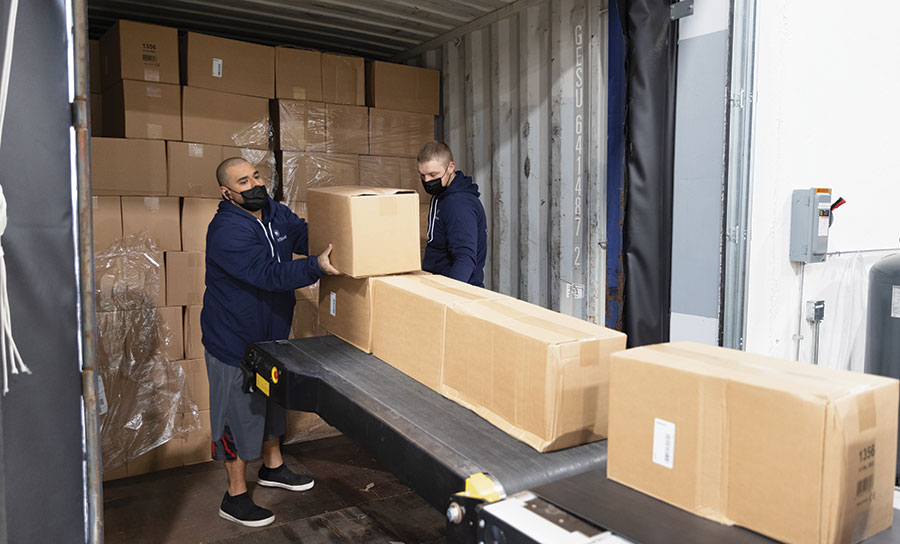
In receiving, associates unload cartons onto an extendable conveyor.
The difference a year makes
Like last month’s cover story on Top Notch Distributors, NorthShore Care Supply goes deep in a niche Industry. In this instance, it’s an extensive catalog of incontinence products along with personal products essential for daily living.
What the two companies share with many small to mid-sized distributors of specialty products is that they have to compete head-to-head on price and customer service with retail and e-tail giants, including Amazon.
They often distinguish themselves on selection and customer service. That includes knowledgeable customer service representatives who are experts in the product lines to help a new customer select a product that will improve their lives, along with consistent, reliable and superior order fulfillment and delivery. People need these products when they need them.

Cartons are conveyed to the palletizing cell.
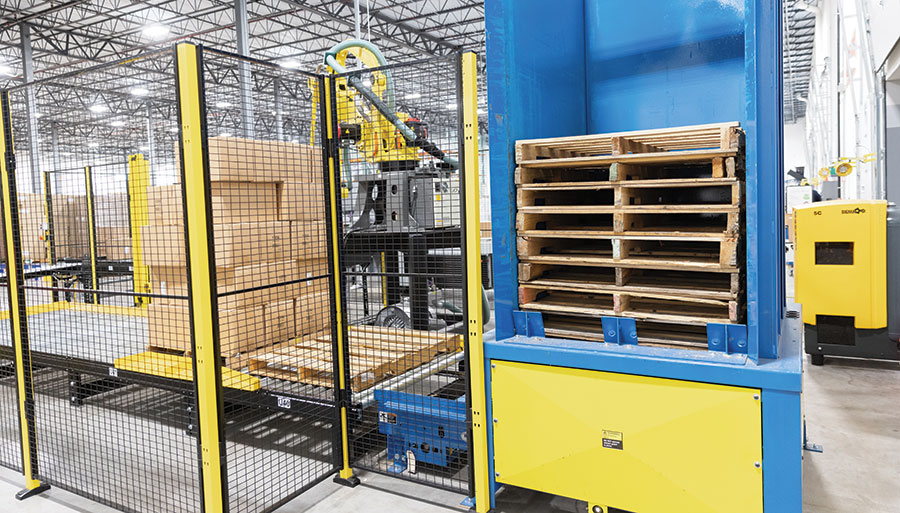
Pallets are automatically dispensed.
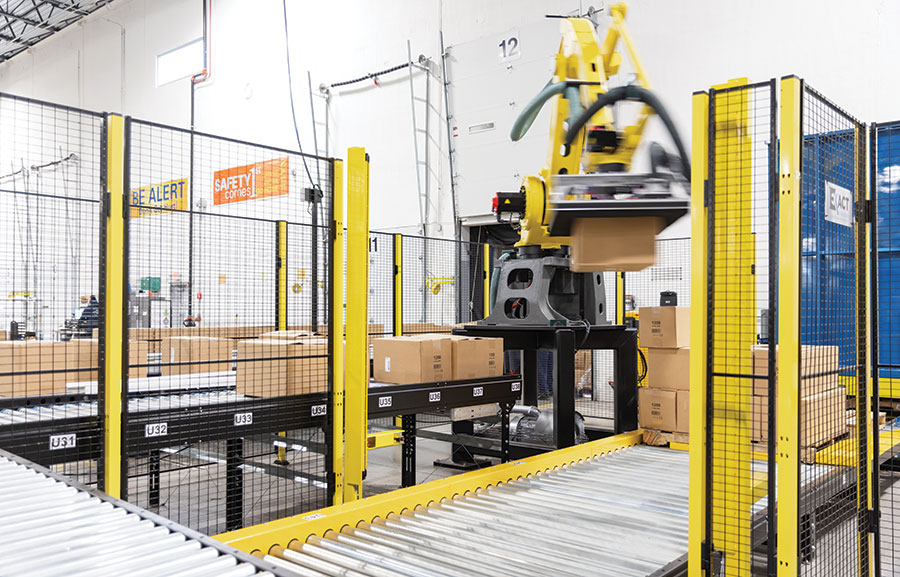
The robot picks up cartons from the conveyor.
As the price of computing power and electronic components has come down, emerging automation technologies are putting powerful new tools in the hands of small companies and enable them to compete on service and keep pricing structures in check. After all, people will only pay so much, even for superior products. As Greenberg told us last year, automation is a competitive advantage, and to get the most for it, he looks for cutting-edge providers that may be looking for a beta site to put their technology to the test.
In the year since my visit to NorthShore Care Supply, the business has continued to grow and evolve. Meanwhile, Greenberg is experiencing the same labor shortages and supply chain disruptions as most other manufacturers and distributors, regardless of size. So, what’s happened?
For one, the privately held company has continued on its growth path, driven in part by the “general boom in e-commerce in all categories,” says Greenberg. “Before Covid, the biggest share of our marketing was to get people out of the stores and into the routine of buying online. Now, if they do go into a store, not everything is on the shelf, and in this category, a necessary specialty item, buying online is more reliable.”
Secondly, private label NorthShore branded products are becoming more of a focal point of the business. “It’s grown from 80% of the business a year ago to more than 90% today and will be more than 95% of our business by the end of this year,” Greenberg says.
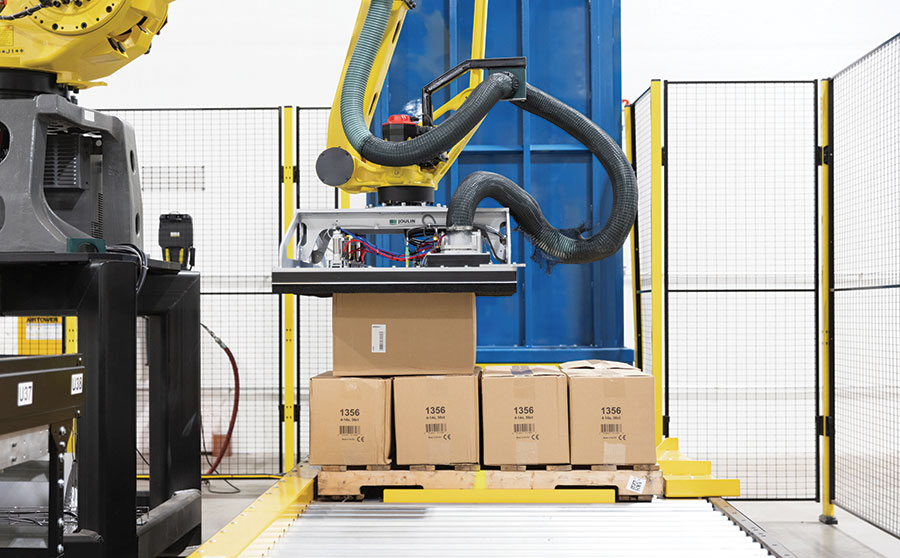
The robot builds the pallet from a number of stored palletizing pallets, according to the SKU.
The increase in private label product increases NorthShore’s reliance on manufacturers in the United States, Europe and China, and now shipments back to customers in Europe. As a result, the company is experiencing shutdowns, shortages and unpredictable shipping.
“Our overseas suppliers are backlogged and our domestic suppliers are shut down,” he says. “Lead times from Asia have grown from 5 weeks to 15 to 20 weeks, and we have to add an extra 4 to 6 weeks from Europe. And, we’re paying extra.”
Meanwhile, NorthShore Care’s customers rely on its products, so the company is ordering “just in case inventory, and then we add some,” says Greenberg, explaining the reason for the extra inventory in the facility compared to a year ago. The result is that “our receiving operation is experiencing twice the growth rate of our outbound operation,” he adds.
Meanwhile, containers…
[ad_2]
Source link






Leave A Comment
You must be logged in to post a comment.